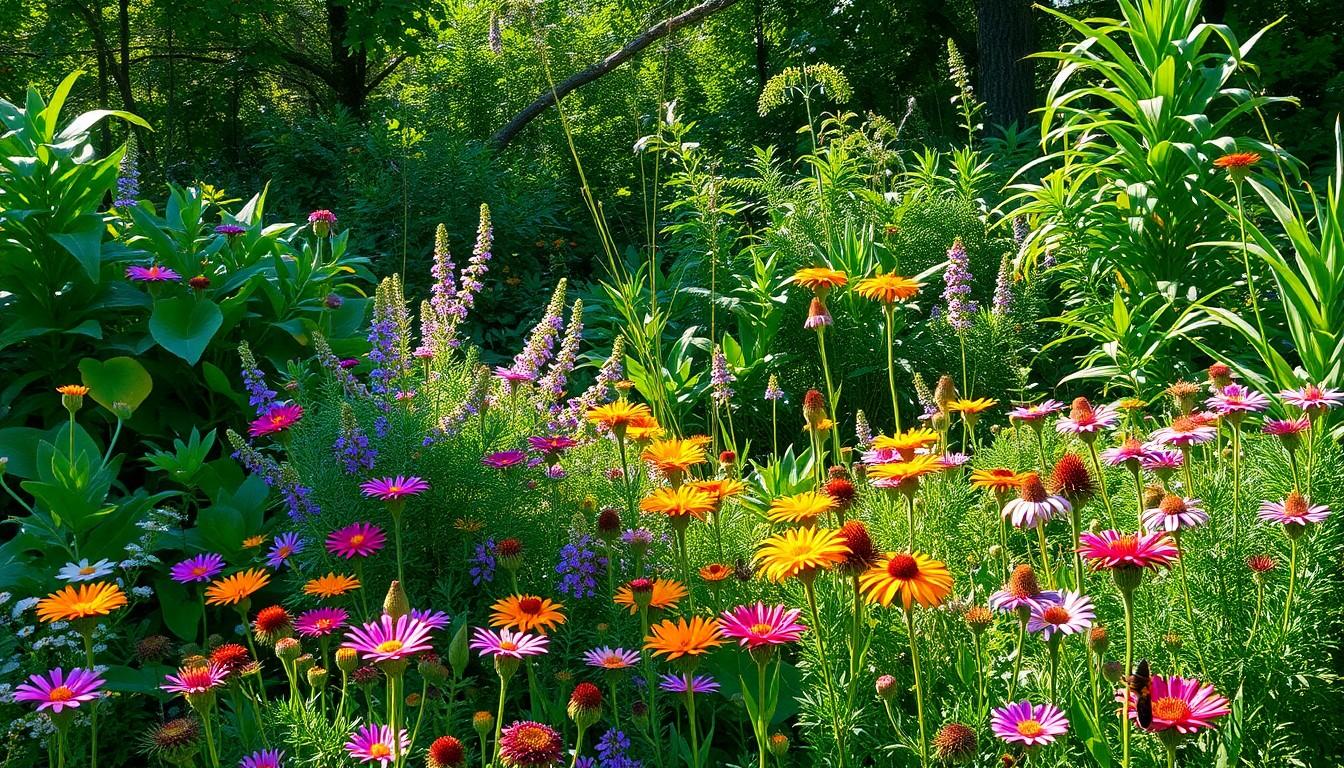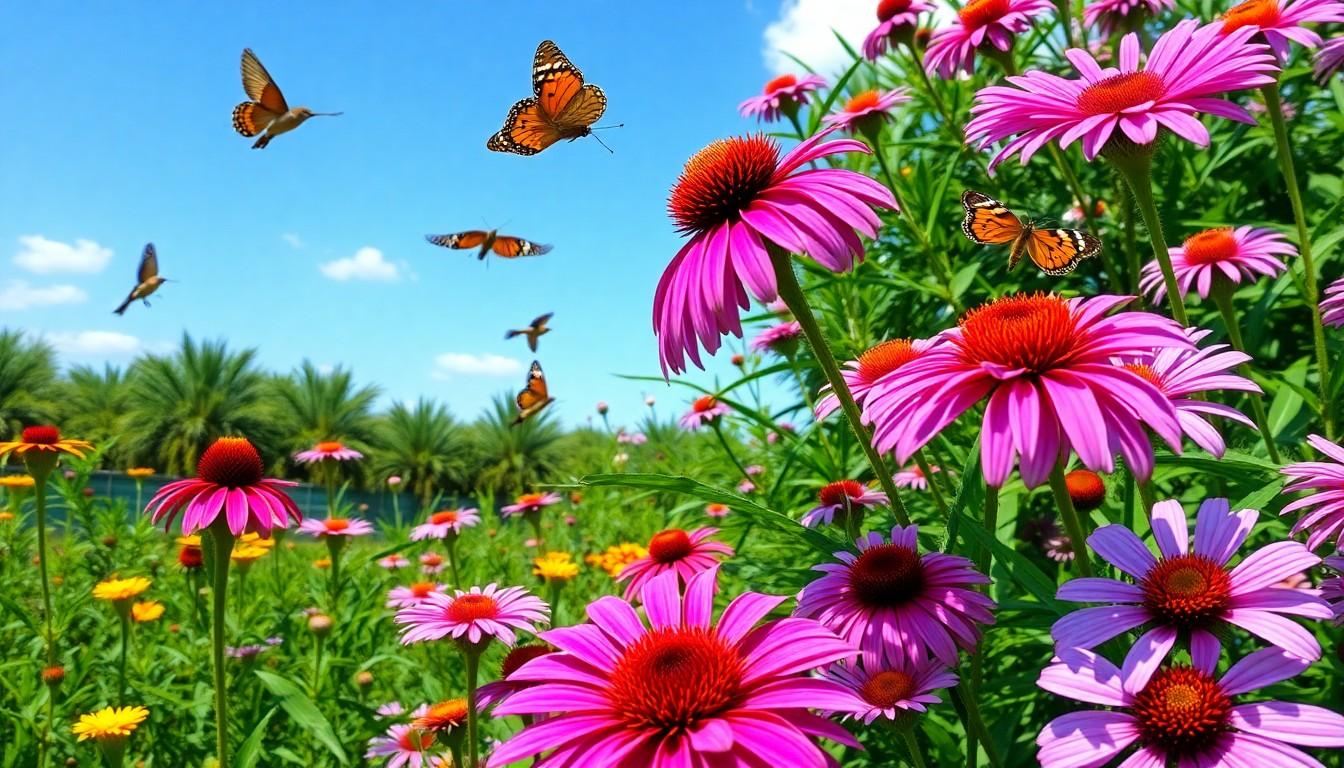Florida’s got a reputation for its sunny beaches and vibrant nightlife, but there’s a hidden gem waiting to be discovered right in your backyard—native plants! These green wonders not only add beauty to any landscape but also play a crucial role in supporting local wildlife. Imagine a garden buzzing with butterflies and chirping birds, all thanks to the plants that naturally thrive in the Sunshine State.
Overview of Native Plants in Florida
Native plants in Florida play a crucial role in the state’s ecosystems. These plants are well-adapted to the local climate and soil conditions, which boosts their survival rates. Conservation of native species supports local wildlife by providing habitats and food sources.
Various types of native plants flourish in Florida’s diverse environments, including wetlands, coastal areas, and upland regions. For instance, the Saw Palmetto thrives in sandy soils, while the Florida Anise grows well in moist, shaded areas. Both of these plants contribute to the biodiversity that characterizes Florida’s landscapes.
Gardeners and landscapers benefit from using native plants due to their low maintenance needs. Once established, native plants require less water, making them ideal for sustainability efforts. They also resist pests and diseases more effectively than non-native species. Many landscaping services in Toronto are increasingly incorporating native plants into their designs to create eco-friendly, low-maintenance outdoor spaces that thrive in the local climate.
Many native plants offer aesthetic value through their unique blooms and foliage. Species such as the Purple Coneflower and the Blanket Flower attract pollinators, adding vibrant colors to gardens. Additionally, ornamental grasses like Muhly Grass enhance visual interest while providing habitat for birds and small mammals.
Understanding the significance of native plants not only helps to protect Florida’s ecosystems but also promotes local heritage. Engaging with native species strengthens residents’ connection to the natural landscape, fostering a sense of stewardship for the environment. By incorporating these plants into landscapes, it creates a balance between beauty and ecological responsibility.
Benefits of Native Plants

Native plants offer numerous benefits for both the environment and the economy. Their role in promoting biodiversity and creating sustainable ecosystems cannot be overstated.
Environmental Advantages
Native plants enhance local ecosystems by providing crucial habitats for wildlife. They attract pollinators like bees and butterflies, contributing to ecological balance. Water conservation often improves with their use, as these plants require less irrigation once established. Soil health benefits, too; native plant roots help prevent erosion and improve soil structure. Pest resistance lowers the need for chemical treatments, fostering a healthier environment. Lastly, native plants can flourish with minimal maintenance, allowing landscapes to thrive without excessive input from gardeners.
Economic Benefits
Using native plants can significantly reduce landscaping costs. These plants typically require less water, resulting in lower utility bills for homeowners and businesses. Reduced reliance on pesticides and fertilizers translates to fewer expenses for maintenance. Landscaping with native plants can also enhance property values, making any space more appealing to potential buyers. Local nurseries and garden centers benefit from selling native species, boosting the regional economy. Shifting toward native landscaping leads to a more sustainable environment while promoting economic growth within local communities.
Popular Native Plants in Florida
Florida boasts a diverse array of native plants, each contributing uniquely to the state’s ecosystems.
Trees
Many native trees thrive in Florida’s climate, providing essential habitats and shade. The Bald Cypress stands out for its ability to flourish in wet conditions, commonly found in swamps and floodplains. This tree supports various wildlife, including birds and small mammals. Another example is the Live Oak, known for its sprawling branches and majestic presence. It serves as a critical habitat for birds, squirrels, and insects. Additionally, the Sabal Palm, Florida’s state tree, is widely recognized. This palm not only offers beauty but also provides food and shelter for local fauna.
Shrubs
Several native shrubs play a vital role in Florida’s landscapes. The Coontie shrub is noteworthy for its resilience in sandy soils and its association with the Atala butterfly. Another significant choice is the Florida Anise, which thrives in moist, shaded environments. Its aromatic leaves enhance local gardens while attracting pollinators. The Blueberry shrub adds culinary value, yielding delicious fruits enjoyed by both humans and wildlife. These shrubs require minimal maintenance, making them ideal for sustainable landscaping projects.
Flowers
Florida’s native flowers add vibrant colors and attract diverse pollinators. The Purple Coneflower, with its striking purple petals, draws bees and butterflies, enriching local ecosystems. Another beautiful option is the Blanket Flower, featuring red and yellow blooms that brighten any garden. This flower not only enhances aesthetics but also supports pollinator populations. The Coral Bean offers unique red tubular flowers, attracting hummingbirds and adding visual interest. These native flowers thrive in Florida’s conditions, providing easy care while enhancing biodiversity in gardens.
Planting and Caring for Native Plants
Planting and caring for native plants involves understanding their specific needs. These plants thrive in Florida’s unique conditions, making it crucial to provide suitable soil and care practices.
Ideal Soil and Conditions
Native plants prefer well-drained soil that mimics their natural habitats. Sandy soils suit species like Saw Palmetto, while moist, rich substrates benefit Florida Anise. Sunlight plays a significant role; many native plants flourish in full sun, though some tolerate partial shade. A soil test offers guidance on pH levels, ensuring the right nutrients are available. Amendments, like compost, can enhance fertility and soil structure. Understanding these conditions promotes robust growth and sustainability for Florida’s native flora.
Maintenance Tips
Maintaining native plants requires less work than their non-native counterparts. They typically need minimal irrigation once established, thriving on natural rainfall. Routine mulching conserves moisture while suppressing weeds. Proper pruning enhances air circulation and encourages healthy growth. Wildlife-friendly practices, like avoiding chemical pesticides, support the ecosystem. Monitoring for pests ensures early detection of any issues. Regular observation contributes to a flourishing native garden while fostering a connection to local ecology.
Conclusion
Embracing native plants in Florida offers a pathway to a more sustainable and beautiful environment. These plants not only enhance local landscapes but also support essential ecosystems and wildlife. By choosing native species, gardeners can enjoy vibrant gardens with minimal maintenance while contributing to the preservation of Florida’s unique biodiversity.
As awareness grows about the benefits of native landscaping, more residents are likely to appreciate the balance between aesthetics and ecological responsibility. Ultimately, incorporating native plants fosters a deeper connection to the land and encourages stewardship for future generations.

